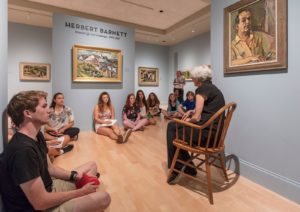Every exhibit has a theme, so what happens when you pull objects from a collection to form an exhibit and you feel like the exhibit is lacking in an area? This is when the role of additional objects comes into play. In order to choose an object that fills one of these gaps, one must look at the exhibit as a whole. In the case of the “House to Home” exhibit, the objects contained within have a strong connection to American Colonial life. Alongside the Colonial life, there is also a strong emphasis on items that were considered curios. The known history of these objects is centered around their donors, and the basic information of their base culture.
So then where do we go from here, what objects should we choose to round out the exhibit? As a collective agreement, the additional objects group was keen on including some model houses. We wanted to show the diversity among the different concepts of home. The exhibit adequately displayed the diversity and multi-use nature of objects within the home, but the idea that there is more than one concept of a home, alluded the exhibit. We focused on the fact that a home was derived from cultural ques, that the physical manifestation of the home would reflect the culture as a whole. Among the many model houses we were able to choose, the Nippa Hut provided a unique advantage: the roof is removable to be able to look into the interior. By selecting this object, we have allowed the visitor to gain insight into the Philippine life, allowing them to draw conclusions as to why the house is constructed the way it is.
Additionally, we sought to include an item that would convey a more communal “home”. Model houses and individual objects were unable to capture this idea, so, despite the many downfalls a diorama can have, we elected to include a diorama of a North West Native American tribe. Aware of the possibilities of inaccuracies within the diorama, we focused all and any text on the communal aspects of living within certain tribes in the north west, highlighting that a home can be more than just a building, but a community from which one resides.
The final object selected provided an interactive aspect to the exhibit, a dollhouse. Dollhouses have a rich history behind them, originally being used as a show of wealth then transforming into teaching tools. These houses provided an answer we had been searching for to the question of how is home taught, how is it passed down? Dollhouses, in the 17th century were a teaching tools used by mothers to demonstrate how to properly run a household. Daughters would gain experience with practice situations with the furniture and dolls in the houses. This would include practice dinner parties, giving orders to servants, and how to ensure the right food would be cooked. This teaching practice did not fade, it carried on well into the 1950s, where young girls pretended to be the perfect housewife. The decision to include an older model of a doll house, one that resembled those used to show wealth, then and interactive dollhouse provide a manner in which thought can be evoked. Our goals are to have each visitor question what their value of home is, how they achieve it, and by all means, who instructed them on constructing a “home” of their own.

